#Canaanite origin of Judaism
Explore tagged Tumblr posts
Text
youtube
Title: YHWH had a Wife? Channel: ReligionForBreakfast (Dr. Andrew Henry) Length: 4:54
Explores a temple with evidence for worship of two deities; YHVH and his consort or wife. Inscriptions elsewhere describe YHVH and "his Asherah." Asherah is a Canaanite goddess, consort to Canaanite god El. References to "his Asherah" may be referring to a now-unknown object. Word "Asherah" appears 40 times in Bible and is usually referring to cult object and not a deity. Touches on diversity in ancient Israelite religion.
#Asherah#Asherah Poles#Ancient Israelite religion#Canaanite religion#Canaanite origin of Judaism#Youtube
6 notes
·
View notes
Text
Me: I don’t deny your identity. I acknowledge Palestinians exist today.
Them: Jesus was a Palestinian, not a Jew!
Me: Well, no - he was a Jewish rabbi. He had a bris, kept Shabbat, kept kosher, & his “Last Supper” was a Passover Seder. Besides, nobody would be called “Palestinian” for ~1,900 years after #Jesus died.
Them: Jews are #Khazars with no history in Palestine!
Me: Well, no - millions of DNA samples have now scientifically proven that Ashkenazi Jews (like their Sephardi & Mizrahi brothers & sisters) originate from the Levant (Israel).
Ashkenazi Jews migrated to the Rhineland (western #Germany) between 800-900 CE.
#Yiddish - the language spoken by #Ashkenazi Jews for a millennia - is a mixture of Jews’ original Hebrew & adopted #German.
Meanwhile, there is no evidence of any Khazar influence on Ashkenazi customs, language, or culture.
The #Khazar tale (claiming some or many Turkic Khazars converted to #Judaism), while interesting, is not supported by any archeological evidence, and can be considered nothing more than a story.
Besides, it’s unassailable that the Ashkenazim were living ~1,500 miles from the Khazars, which may as well have been on the moon in the Middle Ages.
Them: Palestinians are Canaanites, the original inhabitants of the Land!
Me: Well, no - there’s zero evidence the Palestinians are Canaanites. This theory followed other similarly false claims over the past several decades that the Palestinians descend from the Philistines (an ancient Aegean Greek “sea people”) and even the Jebusites - a people for whom there is no evidence outside of the Bible of their having ever existed (if they did, they have been gone for at least 3,000 years).
One thing is clear, all of these recent tall tales about Palestinians’ ancient roots in “Palestine” were created in an attempt to delegitimize the State of Israel & not as some academic attempt to find Palestinian roots.
The #Canaanites (who spoke a language similar to #Hebrew, not #Arabic) have been extinct for more than 3,000 years; and there are no #Canaanite influences in any modern Palestinian language, culture, cuisine, customs, or religion.
Furthermore, DNA studies now prove Canaanites are closest in descension to modern-day Armenians & Western Iranians - but, culturally, there has not been a “Canaanite” people in ~3,000 years.
Meanwhile, there is a practically infinite amount of archeological, biblical & non-biblical text, and architectural evidence proving beyond any doubt that Jews lived in the Land of Israel continuously for more than 3,200 years.
Arabs only started arriving in Eretz Israel in significant numbers during the Arab Imperial conquest out of the deserts of the Arabian Peninsula in the mid 7th century CE when the Land was still majority-occupied by ~350,000 Jews.
Arab conquerers #colonized the Land of Israel & subjugated the Jewish majority.
That’s right, the Arabs were the #colonizers - this is historical fact no matter how much that might make your head hurt.
Them: The Jews are foreigners who stole Palestinian land!
Me: Ok, now you’ve officially ticked me off by repeatedly denying MY identity - one that was OBVIOUS to everyone before the last ~55 years when KGB-inspired propaganda went into mass effect in an effort to delegitimize Israel.
Can’t say the same about your identity … even though I keep trying to offer to respect it!
The Arabs only ruled Eretz Israel after conquering it in the 7th century & until they were kicked out by the Seljuks ~400 years later. Never during that time, did they even attempt to establish an Arab or #Muslim state or capital anywhere in Eretz Israel (Jerusalem is never mentioned in the Koran, and while the city is holy to Sunni Muslims, it is not holy to Shia Muslims).
And during the time of Arab rule, there was obviously no state or country called “Palestine.”
Then, during the 400 years before the start of the British Mandate around 1920, the Land was a distant & severely neglected province of the Ottoman #Turkish Empire.
In fact, in the late 19th century, as Jews began moving back to their homeland in larger numbers, there were only ~200,000 people living there (mostly a sparse, nomadic population), and Jews were the majority in #Jerusalem.
Post-WWI, the League of Nations (the precursor to the UN) legally granted Britain a "sacred trust" called the Mandate for Palestine (a name given to the land by Roman Emperor Hadrian in 135 CE).
The Mandate for Palestine was the least controversial of the 15 post-WWI mandates because everyone KNEW Jews were from “Palestine.”
So the Mandate for Palestine, which included the legal requirement for Britain to aid in the establishment of a Jewish National Home, passed unanimously by the League of Nations.
Among other things, the unanimously passed & legally-binding Mandate recognized “the historical connection of the Jewish people with Palestine and to the grounds for reconstituting their national home in that country.”
Besides, before the Jews started returning to the Land in large numbers in the late 19th century, it had become almost entirely war-torn ruins, arid desert & malarial swamps.
But the returning Jews were determined to rebuild their homeland; and the evidence is undeniable that Jewish labor & the Western technology they brought along helped to make the desert bloom again.
The result of a new booming economy in the midst of mostly rural, undeveloped land is no surprise; and hundreds of thousands of Arabs from neighboring lands immigrated to Mandate Palestine in the early to mid 20th century.
In fact, once Arabs began to rebel against the Jews (with pogroms & full-blown barbaric massacres on a particularly wide scale in 1920, 1921, 1929, and in 1936-1939), they made extremely clear to the British that they resented the name “Palestine,” which they claimed (incorrectly) was a modern Zionist invention.
For example, at the British Peel Commission in 1937 (looking into Arab riots from the year before), local Arab leader Audi Bey Abdul-Hadi testified that “[t]here is no such country [as Palestine]! Palestine is a term the Zionists invented!”
Again, during the 1946 Anglo-American Committee of Inquiry that was set-up to make recommendations for the territory, Arab-American historian Philip Hitti testified, “There is no such thing as Palestine in [Arab] history, absolutely not.”
The Arab position was not particularly surprising, as "Palestine” is not an Arab word (Arabic does not even have a letter “P” or a sound for “P,” which is why you often hear Arabs today pronounce it with a “B” as “Balastine”).
The Arabs in the Land at that time mostly identified with their local clan & otherwise considered themselves “Arabs” of “Southern Syria.”
In fact, just about anyone who was called a “Palestinian” pre-1948 was a #Jew.
This is why nobody made any attempt to create a “Palestinian state” during the 19 years between 1948 and 1967 in which #Egypt occupied #Gaza & #Jordan occupied the “#WestBank.”
The hard truth - even though I’m still acknowledging a #Palestinian people exists today - is that an Arab “Palestinian” identity was created for the first time in any signifiant way at the height of the Cold War in the mid-1960s & at the behest of the #Soviet#KGB, which wanted to expand its influence in the region, undermine the only democracy in the Middle East, and which had been repeatedly embarrassed by Israeli victories over invading Soviet-backed & Soviet-armed Arab states.
So the KGB wrote the ridiculous “Palestine Liberation Organization” (PLO) charter & molded Yasser Arafat at what was known as “KGB U” in #Moscow to use #terror & #propaganda to destabilize Israel.
Over the decades since then, many Arabs in the Land have come to self-identify as “Palestinians.”
Even among Palestinians today, however, many still identify with their clan over a separate “Palestinian” nationality (e.g., the clans do not intermarry & many are constantly engaged in some degree of violent conflict).
And the 2 million+ Arabs citizens of the State of Israel (who have equal protection under the law & more rights & privileges than they would have in any Arab and/or Muslim country on Earth) almost exclusively identify as either #Israeli-#Arabs or as simply #Israelis - not as #Palestinians.
Them: #Jews … I mean #Zionists … are bad, ok? Just ask the UN.
Me: Right. Just ask the #UN
Captain Allen
@CptAllenHistory
597 notes
·
View notes
Text
Steven Dillon's conversion to Christianity: what does it mean to Hellenism and Pagan Community?
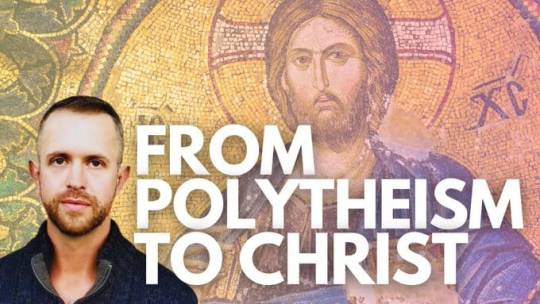
Steven Dillon, the author of "The Case for Polytheism" and "Pagan Portals - Polytheism: A Platonic Approach", recently returned to Christianity.
This event made me think a lot. I think this event can teach us that the more you are concerned with "the One" and you think it can respond, the more likely you will go towards monotheism.
The point is that "the One" is us, and is "a thing", not "somebody".
The One is not a person. This is the reason why we worship the Gods, they are persons.
The One, the All, is so big that the idea that it can listen is nonsense.
Monotheism emerges when you think the entire universe can listen to you. Polytheism is the humbleness to understand that only certain parts of the Universe can listen to you.
And when you think you are talking to the One you are always actually talking to a part of it.
This is the reason why Christ, Yahweh, Allah, etc. are parts of the One and not the One.
Even attempts to interact with the entirety of the One are just interactions with parts of the One, ie one of the many Gods.
This is confirmed by Aleister Crowley's experience, we can read from the Liber Astarte Vel Berylli that he considered Allah, Christ and Yahweh as Parts or Aspects of the One, exactly as other Polytheistic Deities, and not as the All/the One in its entirety:
"Let the devotee consider well that […] Christ and Osiris be one […]".
"As for Deities with whose nature no Image is compatible, let them be worshipped in an empty shrine. Such are Brahma, and Allah. Also some postcaptivity conceptions of Jehovah".
"[…] the particular Deity be himself savage and relentless; as Jehovah or Kali."
-
Moreover, Dillon was (is?) Platonic, and the problem is even worse, because sadly the reaction to the problem of evil is very similar between Platonism and Christianity.
However, the Stoic (and maybe the Hindu and Buddhist) worldview completely destroys the problem of evil, because if the Divine is good and we simply don't perceive the goodness and that is what evil is, ie ignorance or misperception, then the problem of evil is solved.
If we, instead, perceive the evil as something real and the Gods as totally good not evil, the problem of evil remains.
-
Finally, a Pagan that comes back to Christianity usually doesn't know history very well, and is unaware of Natib Qadish, ie Modern Canaanite Religion or Neopaganism.
If you listen to Natib Qadish (ie Canaanite and Israelite Polytheistic Neopaganism) and Wathanism (Arabian pre-Islamic Polytheistic Neopaganism) practitioners' voices, you cannot come back to Christianity.
In fact, Christianity doesn't make any sense: Yahweh is a Storm God that comes from Edom to Israel through the Kenites or Shasu, which were nomads. His name meant "to blow", and so he was a variation of Baal Hadad.
In the origin, El was the father of Baal/Yahweh, and his sister was Anat and his mother Asherah. Later, El ie the Sky God and Yahweh ie the Storm God, merged and so Yahweh was seen as the husband of the Goddess Asherah.
In fact in Kuntillet Arjud it's possible to see blessings by "Yahweh and his Asherah". Moreover, even the Bible (read The Book of Judges) witness that people worshipped Asherah/Astarte and Baal together with YHWH.
In Elephantine in Egypt there was a Jewish temple for Yahu-Anat, ie both Anat and YHWH.
So how can Jesus be the son of the only God Yahweh if Yahweh was never a monotheistic God before the Josiah's reform that made Judaism monotheistic?
If Judaism is originally polytheistic then Christianity makes no sense.
By reading the "Cycle of Baal" we'll discover the origin of the Biblical Deity (or Deities?).
youtube
I end my dissertation with some interesting quotes from the Bible:
Jeremiah 7:
"17 Do you not see what they are doing in the towns of Judah and in the streets of Jerusalem? 18 The children gather wood, the fathers light the fire, and the women knead the dough and make cakes to offer to the Queen of Heaven."
Jeremiah 44:
"17 We will certainly do everything we said we would: We will burn incense to the Queen of Heaven and will pour out drink offerings to her just as we and our ancestors, our kings and our officials did in the towns of Judah and in the streets of Jerusalem. At that time we had plenty of food and were well off and suffered no harm. 18 But ever since we stopped burning incense to the Queen of Heaven and pouring out drink offerings to her, we have had nothing and have been perishing by sword and famine.”
"19 The women added, “When we burned incense to the Queen of Heaven and poured out drink offerings to her, did not our husbands know that we were making cakes impressed with her image and pouring out drink offerings to her?”"
"25 This is what the Lord Almighty, the God of Israel, says: You and your wives have done what you said you would do when you promised, ‘We will certainly carry out the vows we made to burn incense and pour out drink offerings to the Queen of Heaven.’"
#Hellenism#Paganism#Polytheism#devotional polytheism#Christianity#Canaanite#Platonism#Neoplatonism#Natib Qadish#Youtube
34 notes
·
View notes
Text
by Jack Elbaum
Political commentator Candace Owens said on her YouTube show on Tuesday that the Star of David originated from an evil pagan deity and has only become associated with Judaism within the past few hundred years, continuing the prominent provocateur and media personality’s recent focus on Jews and conspiracy theories associated with them.
“Do you know the history of the Star of David?” she asked on her show. “I thought that that was associated traditionally, somehow, with Judaism.”
The right-wing firebrand went on to argue that, in truth, the Star of David only became associated with Judaism when European Jews decided to adopt it as a symbol comparable to the cross a few hundred years ago. Then, when the Zionist movement adopted it in the late 1800s, that is when it became the symbol people think about today, she claimed.
However, many Jewish ancient artifacts have been found to have the Star of David on them. There were also other cultures, including pagan ones, that used the symbol. Additionally, the term “Magen David” — the “shield of David” — is referred to in the Talmud, although not specifically as the six-pointed star symbol.
Owens said that the true origin of what is today called the Star of David was actually the Star of Remphan, a pagan god worshiped by the Canaanites and who was regularly offered child sacrifices. As proof, Owens showed a picture from the internet that claimed to depict the Star of Remphan as a six-pointed star. However, there is no agreed-upon idea of what the Star of Remphan is actually supposed to be.
She went on to link these stars with demons and sorcery.
It appears Owens gathered much of the information to make her argument from Wikipedia. “If it’s on Wikipedia … that just must mean that it’s such an irreversible fact,” she said.
#candace owens#moron#complete utter moron#star of david#wikipedia#star of remphan#canaanites#evil pagan deity
32 notes
·
View notes
Text

✧ Introduction to Yahwism ✧
Yahwism is a iron age religion from the Isrealite tribe from before the existence of Israel. According to the story, the Israelites were saved from slavery in Egypt when the god, Yahweh, came to set them free. Yahweh had become the god of the Israelites. As the Israelites met the Canaanite tribe, they adopted the worship of the gods El and Ba'al along with the goddess Asherah. Asherah had been seen as being the consort of Yahweh. As time went on, prophets of Yahweh and the rest of the Israelites, began becoming unhappy with worshipping other gods along side Yahweh so they destroyed idols of Asherah and banned the worship of the other gods, though this did not completely stop the worship of them. The Israelites saw Yahweh as the only deity worth worshipping in their tribe so they abandoned polytheism but still being aware of the existence of the other gods. As time went on and Israel came to be, Judaism and Christianity branched off from Yahwism but Yahwism is absolutely NOT Judaism or Christianity. Yahwists only follow the teachings of the Tanakh (hebrew old testament) as it was the first bible. Yahwists do believe in Jesus but only as a prophet and only use his original name, Yahshua. Yahshua only said he was the son of Yahweh but as a metaphor for being a believer and follower.
Differences:
Yahwism
~ Focus is Yahweh and His holy spirit
~ Follows the Tanakh
~ Yahshua (Jesus) is only a prophet
~ There is no hell, either eternal life for the worthy or eternal oblivion for the non-worthy
~ Using the labels "God" or "Lord" is seen as disrespect as they are not Yahweh's name
Christianity
~ Believes in the holy trinity, Jesus is a form of God
~ Uses the labels "God" and "Lord"
~ Contains the new testament, which is Roman in origin
~ Believes in hell
~ Celebrates easter, christmas, etc.
~ Uses holy water and holy oil
~ Believes in judgement day
Judaism
~ Uses the labels "God" and "Lord"
~ Believes using the name "Yahweh" is disrespectful and too divine to be said
~ Not much focus on the afterlife, focus is life on earth
~ Follows the Tanakh
~ Celebrates chanukah
34 notes
·
View notes
Text
Debunking the claims about Nur Masalha
@autistic-ben-tennyson
@jewishvitya
Hi, I saw a post made by a zionist which states:
"Nur Masalha is a poor quality source, and not worth invoking on the issue of "what was the spectrum of early Zionist thought, how did they envision living with Arabs?"
As evidence they linked two sources which I want to take a crack at debunking. The OP made some claims about Nur Masalha, including that he "relies on many unsupported or blatantly false assertions all aimed to whitewash Jewish history and deny an indigenous Jewish identity" including:
Jews learned monotheism from the Koran
Ashkenazim are all European converts (Khazar theory)
Herod was not Jewish and he ruled from Aelia Capitolina a century before the Romans named it such, with "Jerusalem" never having been a significant part of Jewish culture anyway (no, really)
"Palestine" was the indigenous name of the land, according to entirely imperialist sources: Greeks, Assyrians, Romans, etc.
The Arab conquest of the land was "glorious," "spectacular," etc.
Chaim Weizmann called Arabs the n-word"
Right now I havent read through any of his books to check for the veracity of these claims, but I can explain why the articles the OP linked aren't reliable sources.
The first one is "The Distortion of Palestine" by Tel Aviv of Books. The author claims that Palestinians "clearly have their origin in 7th century Arabia" which is completely bull. Oh boy, where to begin?
The idea that "jewish people have been in Palestine before muslims and arabs" is prevalent among zionists who want to deny the Palestinian connection to the land and their claim to indigeneity, but its far from accurate.
The argument is simple to follow: Palestinians today are mostly Arabs. The Arabs came to the Levant with the Muslim conquest of the region. Therefore, Arabs -and as an extension Palestinians- have only been in Palestine and the Levant since the seventh century AD.
However, researchers have known that Palestinians share a significant amount of their DNA from ancient Canaanite populations that lived in the region which is now Palestine:
"A 2021 study by the New York Genome Center found that the predominant component of the DNA of modern Palestinians matches that of Bronze Age Palestinian Canaanites who lived around 2500–1700 BCE."
Nathaniel Pearson: The splendid tapestry: How DNA reveals truths, ancient & lasting | TED Talk
Before the islamic conquests the population in Palestine was mostly Christian, having converted from Judaism, and afterwards the people slowly converted to islam, and it took a couple of centuries before the majority became muslim.
Also, dismissing Palestinians as "just arabs" has additional problematic implications: this is not just denying the existence of Palestinians as a distinct people, but the logical conclusion of this stance is that the entirety of the arab population across MENA are one homogenous, interchangeable mass who aren't really native to their homelands, which is probably the most ignorant and bigoted garbage I can't believe "liberals" really believe in.
The author also has this to say about Mexicans:

"But this is like writing that the Mexicans are the indigenous people of Mexico" using the author's logic, the entire Spanish-speaking populations across latin america are really from Spain and have no ties to indigenous culture, which is far from true. I'm not particularly knowledgeable about how indigeneity works in Mexico, but that hardly seems accurate.
A lot of the statements are made in bad faith and contradict themselves.
It is laying on a bunch of unspoken premises and beliefs that are of course natural and unquestionable from the Zionist perspective- such as the idea that Jews and only Jews are allowed to claim nativeness to the region
Rather than the point that the Kingdom of Judea (and the Kingdom of Israel) were just some of many different groups living in that part of the world and the issue isn’t whether or not Jews have historic origins in the region (they do) but rather that those origins gives them the right to carve out a Jewish ethnostate in the region involving the exclusion of a non-Jewish presence.
Basically what I’m saying is, is that the article is sitting on the false premise (being argued in what I consider to be bad faith) that only one specific group gets to claim “indigenousness” and that the proof of Palestinian existence doesn’t matter because the writer feels there is more proof that Hebrews were there “first.” Frankly, my reading of the historical record pretty comfortably suggests to me that there were multiple groups there because that’s simply how history of time and place works.
This is what I have to say right now, I might write about the second article later, but so far this is what I have.
10 notes
·
View notes
Text
Entities within the World.
This is a non exhaustive list of some of the entities that exist within the story “You are Sheol”. All of these entities are inspired by figures in myths around the world, but are not exactly the same.
Chimeras
Chimeras are inexplicable creatures who defy the natural laws of death. Chimeras do not die when killed, rather, they reorganize their cells and reanimate as a different person with the same memories. Chimeras have the ability to influence the fabric of reality. Notoriously fragile, Chimeras are known to split into separate consciousnesses when severely injured to avoid reincarnation. Chimeras are the only entities observed in creation that are skilled at absorption. There are perfect and imperfect Chimera.

Higher Gods
Higher Gods are entities which exist in dimensions tens to hundreds of layers above ours. Because these entities are so incredibly complex, powerful, and dense, Higher Gods will split their consciousness among thousands of Angels who will all collectively carry out their will. This allows Higher Gods to interact with the universe in lower dimensions without destroying the fabric of everything. Every angel within a Higher God’s pantheon is literally a piece of that God. This means that in order to witness a Higher God, every single angel from its pantheon must be observed in a single realm.
The risk with splitting your consciousness among angels like this is that angels, while extremely disciplined, also have free will and can and occasionally do seek other Gods from other pantheons to work with. Likewise , Angels are known to disagree with each other very often, and conflicts between specific Angels mean the decimation of an entire pantheon.
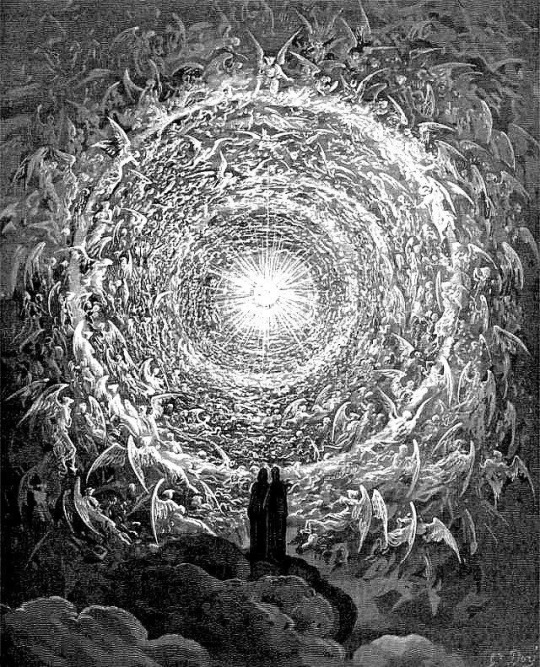
Lower Gods
Lower Gods can be described as Gods whose consciousness can be contained within a single entity. Lower Gods do not split their consciousness among Angels and can operate completely independently. Daemons and Angels alike can become Lower Gods with enough Energy. Lower Gods are known to do magick with humans often. Lower Gods can take Angels and Daemons from other pantheons under their ray. Lower Gods can be worshiped. Lower Gods are not to be mistake for “lesser” gods.
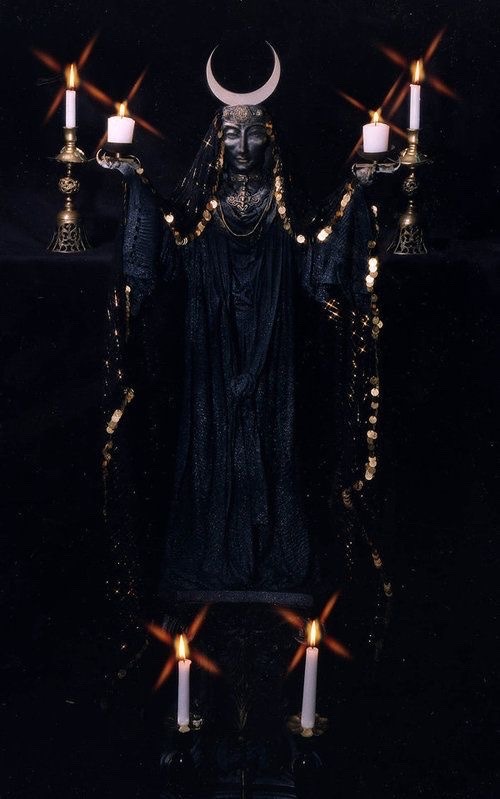
Collective Angels
There are some pantheons that do not follow this traditional understanding of the hierarchy of Angels, some of which may be explored at different times. Our story is mainly centered around a Pre- Abrahamic understanding of the traditional hierarchy inspired by Summaria, Zoroastrianism, Canaanites and early Judaism with a dash of Christianity; however, this pantheon can be considered *somewhat* original as it does not strictly adhere to the beliefs of these faiths. Consider it an eclectic blend of all of these things.
Every Angel looks and behaves entirely uniquely, however, they all share the quality of being highly energetic, incredibly bright burning, intensely massive, lofty entities. Both Angels and Demons present in many forms including humanoid and anthropomorphic. Angels will appear as different sexes at different times. Their truest form is inconceivable to normal Humans.
Highest orders: Seraphim, Cherubim, Thrones.
Middle orders: Dominions, Virtues, Powers.
Lowest orders: Principalities, Archangels, Angels.
(These directional descriptors do not at all reference power or importance, rather consider them explanations of how close or far away from Humanity each order is, with the highest being furthest away. Archangel Jophiel, for example, commands legions of Cherubim even though they are technically in a higher order than her)
Collective Angels work as a hive mind, though they do not all have the same thoughts or opinions. Any prayers made towards The Higher God or energy given is distributed evenly among every single collective Angel.
A Nega (Pronounced Negga)
A Nega ____ can be described as the inverse function of a celestial. Every celestial has an inverse counterpart. The Negas of the 72 Angels of Creation are the 72 Angels of Destruction. Negas also carry out the wills of their God and can be considered a part of the Collective Angels.


^ This song captures the vibes of Collective Angels well
Watchers
A class of Angels that were exiled for lusting after and procreating with Humans.
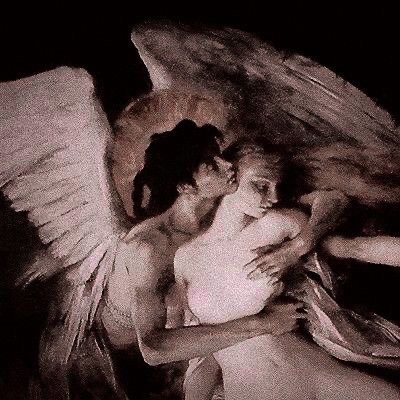
Nephilim
The unholy offspring of Watchers and Humans. Giants.
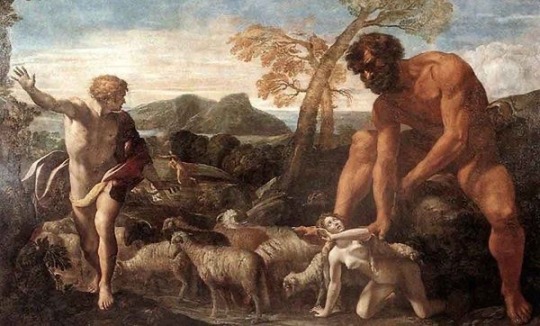
Daemons
The difference between Daemons and Angels is more political than physiological. There are many reasons why an Angel may radicalize and become a Daemon, however, the most common reason is a desire to operate as an individual rather than as a collective. Along with this many Daemons are not fond of the very strict contact rules with Humans that Angels must follow, and would like to do magick with them. “Daemon” is a self proclaimed title. Because Angels and Daemons cannot accept worship, the only time they are able to accept energy from a human as their own is through magical operations and offerings. After being cut from the collective pool of energy collective Angels share, many Daemons utilized magical contracts with Humans to stay self-sufficient.
Daemons are known to have better social skills with Humans than Angels. Daemons do not have Negas. Like Angels, Daemons are free will entities and may or may not be tolerant towards Humans.



^This song captures the vibes of Daemons well.
Djinni, Fairies, Natural Spirits
Human-like entities that existed before humanity. These entities have their own beliefs and religions. All of these living creatures have free will, eat, sleep, procreate, and die.
Thank you for reading! I think in my next posts I’ll explore the main characters of the story.
#Spotify#demonology#folklore#literature#my wrtitng#biblical angel#angelology#witchcraft#magick#esoteric#occult#demons#angels#pagan#mythology#original work#writing#world building#spiritual ascension#energy#You are Sheol#BTower
101 notes
·
View notes
Text

The Levant: A Cradle of Civilization, Migration, and Ideologies
The Levant, a region spanning modern-day Palestine, Lebanon, Syria, Jordan, and parts of Turkey, holds a unique place in the story of civilization. As a historic crossroads linking Asia, Africa, and Europe, the Levant witnessed waves of human migration, the rise and fall of empires, and the birth of some of the world’s oldest languages, religions, and ideologies. Ancient peoples migrated here, each wave adding to the region’s complex tapestry, influencing and blending with local cultures. Focusing on Palestine and Lebanon, this article explores how migration fostered civilization, where ideologies emerged, and the Semitic roots that still echo today.
Ancient Migration Patterns in the Levant
Dating back as early as 10,000 BCE, the Levant was home to some of the world’s first settled communities. Archaeological evidence from sites like Jericho and Byblos reveals early agricultural practices and social organization. Migratory groups—ranging from Neolithic farmers to Bronze Age traders—moved across this fertile land, bringing new ideas, crops, and tools. These migrations set the foundation for the urban civilizations that would emerge later, as communities organized around fertile areas and trade routes to form distinct societies.
Formation of Early Levantine Civilizations
The Levant’s fertile land and proximity to the Mediterranean allowed cities like Jericho, Tyre, and Damascus to flourish. This led to the development of city-states that became centers of administration, trade, and cultural exchange. The region's wealth of resources attracted various groups, including Egyptians, Mesopotamians, and later the Greeks and Romans. These early Levantine societies laid the groundwork for governance structures and complex social hierarchies, fostering a shared cultural identity that revolved around trade, religion, and the arts.
Etymology and Origins of "Palestine"
The term "Palestine" is deeply rooted in ancient history. Earliest references date back to Egyptian texts around 1150 BCE, where the term "Peleset" referred to the coastal inhabitants known as the Philistines. This name evolved through Greek and Roman usage, with the Greek historian Herodotus referring to the area as "Palaistine" in the 5th century BCE. By the time of Roman rule, "Palestine" was widely used to describe the region, particularly following Emperor Hadrian’s re-naming of Judea as "Syria Palaestina" in 135 CE after the Bar Kokhba revolt, an effort to diminish Jewish ties to the land.
Palestine Before and After Ideologies
Before formal ideologies and religions took root, Palestine was a cultural and economic hub influenced by both indigenous populations and migratory groups like the Canaanites and Philistines. Its position between powerful neighbors—Egypt, Assyria, and later Rome—meant that local beliefs and practices constantly evolved. Major religious ideologies like Judaism and, later, Christianity and Islam transformed Palestine from a region of polytheistic practices to a bastion of monotheism, a transformation that shaped its identity and significance in global history.
Lebanon’s Unique Role in Levantine Civilization
Lebanon, derived from the Semitic root "LBN" meaning "white," likely refers to the snow-covered mountains of the region. With its strategic location and access to cedar forests, Lebanon became a hub of maritime trade led by the Phoenicians, skilled sailors, and traders who spread Levantine culture across the Mediterranean. Phoenician cities like Byblos, Tyre, and Sidon grew prosperous, enabling Lebanon to play a unique role in regional development as a center for trade, art, and ideology.
The Influence of Semitic Languages in the Levant
Semitic languages, originating in the Levant and Mesopotamia, played a significant role in shaping the region’s cultural and linguistic identity. Akkadian, the earliest attested Semitic language, was prominent in Mesopotamia, while languages like Ugaritic, Phoenician, and Aramaic became widespread in the Levant. The Phoenicians developed an alphabet that influenced Greek and Latin scripts, while Aramaic served as a lingua franca across the Near East, eventually influencing Hebrew and Arabic. This linguistic tradition underscored the shared cultural heritage among Levantine peoples.
Who is Considered Semitic?
The term "Semitic" refers both to linguistic and ethnic classifications. Coined in the 18th century, it derives from Shem, one of Noah’s sons in the Bible, traditionally thought to represent the ancestors of Semitic-speaking peoples. Historically, Semitic groups include the Akkadians, Canaanites, Arameans, and later, Arabs and Hebrews. In the Levant, this classification encompasses various peoples whose languages, customs, and religions were intricately linked, forming the basis of a shared Levantine identity that persists in linguistic and cultural practices today.
Evolution of Religion and Ideologies in the Levant
Religious beliefs in the Levant evolved from early polytheistic practices to the monotheistic religions that define the region today. Canaanite and Phoenician pantheons initially dominated, with deities such as Baal and Asherah central to worship. Judaism emerged, emphasizing monotheism and setting a theological foundation that would influence Christianity and Islam. This transition from polytheism to monotheism introduced new ideologies about ethics, governance, and spirituality, solidifying the Levant as a cradle of religious thought.
The Role of Metropolises in Ideological Development
Urban centers like Jerusalem, Tyre, and Damascus became fertile ground for ideological exchange. The Levant’s cities were gathering places for traders, philosophers, and religious leaders, whose ideas influenced each other and spread throughout the Mediterranean and beyond. From the teachings of Jesus in Jerusalem to the philosophical schools of Tyre, these cities fostered an intellectual environment where religious and political ideologies could grow and diversify, fueling movements that would shape civilizations far beyond the Levant.
Modern National Identities in the Levant
In recent centuries, the Levant has faced waves of colonial rule, each bringing new challenges to national identity. The 20th century, marked by the dissolution of the Ottoman Empire and subsequent European colonization, saw the formation of distinct national identities. Palestinian and Lebanese identities were influenced by a desire for autonomy and resistance to foreign control. The struggle for Palestinian statehood and Lebanese cultural pride are both rooted in the Levant’s complex history, reflecting an ongoing negotiation between ancient heritage and modern aspirations.
Palestine in Modern Geopolitics
Today, Palestine is a central figure in Middle Eastern geopolitics, symbolizing the struggle for self-determination. The Israeli-Palestinian conflict has drawn international
#free palestine#save palestine#all eyes on palestine#free gaza#gaza#gaza genocide#i stand with palestine#palestine genocide#donations#lebanon#israel#israeli occupation#isreal#israhell#history#culture#anthropology#archaeology
7 notes
·
View notes
Text
We LOVE a mysterious lady while waiting for Hazbin Hotel’s marvelous first season to wrap up. Let’s talk about Lilith and Eve!

There’s so many ways this could go. Applause to Vivienne and Co. for making this fun with what I am sure are ample red herrings. I hope those involved in the show are having great chuckles as we feverishly wonder what is really going on.
First, some groundwork so that we’re on the same page. I’m nearly certain Sera is not the highest up in Heaven, whether in order or entity. This may be the common “God sleeps, knows all, and refuses to be involved”, which is always a fun, good move for narratives. Orrrrr, it might be some of my theories.
And on the subject of narratives, we should acknowledge that Charlie is telling her parents’ perspective of the beginning of Earth. It may not be the whole story, people may be figurative or portrayed inaccurately, and things may have been omitted.
Now then, my 6 theories!
Theory 1 - Eve is just a regular woman, and no one cares about her after death. High probability that Adam had a lot to do with that.
Theory 2/3 - Eve is God / Eve is the true evil
Let me tell you some ancient religion things. Nothing in this world is isolated. In ancient Judaism, there are references to Asherah, a Canaanite mother goddess and wife to the big god El, particularly as an object of devotion in the form of a tree. Makes sense that the Judeo-Christian God would have a wife if Lucifer does.
Anywho, whether or not this is the inspiration, I wonder if the imagery used in the first scene of the show is meant to hint at the origins, or roots, of evil in the world being an actual enemy. Whatever twist would happen with Eve (or Lilith!) finally appearing, I would expect it to be BIG like this, and the symbolism adds up.
Theory 4 - Eve is Lilith
During the opening sequence, Eve about to eat the apple takes on very similar features to Lilith’s silhouette just seconds later.
This theory goes with the understanding that Eve never existed, or also ran away from Adam but became inconsequential. We never see Eve or Adam as humans again in this sequence, so for all we know this works. Eve could definitely just be symbolic.

Theory 5 - Eve and Lilith are Allies
They are working together on… something. Whatever Lilith and Alastor are connected with, for sure. Perhaps these ladies are triple agents and are infiltrating their respective realms quietly while plotting some sort of takeover or revamp. Perhaps there is a bigger evil / God himself that they are trying to steal power from?
Theory 6 - Lilith became Eve 7 Years Ago
Something happened where Eve was hurt, usurped, or otherwise incapacitated, and Lilith stepped in to prevent a power vacuum. Obviously this can work well off of Theory 5, but it works as an enemy simply taking advantage, too.
BONUS Theory 7 - Lilith and Lucifer are Allies
Once again, they’re working together on something nefarious. Eve may be the baddie (or goodie) or not even matter, whilst our royal Hell couple has supposedly split up to give the idea they aren’t in communication, and that Lucifer is a non-threat.

I am so glad that we have 2 seasons from the start! There’s so many other thoughts and so much in this show, that at least 2 seasons is definitely needed. To the season finale!
#analysis#hazbin hotel essay#Hazbin hotel#lilith#Eve#Hazbin Lilith#Hazbin Eve#do we have unreliable narrators?#who’s the big bad we haven’t seen yet?#all this and more on Thursday
19 notes
·
View notes
Text
Mythologic Geekery: Ba'al
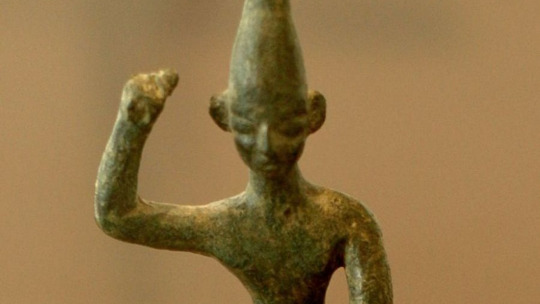
Given that I now have the theory that he might play into Nocturne - and the fact I wanted to speak about Abrahamitic and Semitic mythology this and next week either way... LET ME TALK BA'AL!
So, first things first: Ba'al originally was a title within several of the semitic languages, being best translated with "Lord". So several male gods used the honorific over the time. But within both Babylon and also the Canaanite culture the name became mostly associated with the god Hadad. (While the Phoenicians associated the name with El(ohim) - but I am gonna talk about Elohim next week and he is a bit different, because he never became a demon.)
Hadad was a good mainly of weather (especially storms) and of fertility, being associated with the harvest and agriculture in general. Statues of Hadad were also used in fertility rituals.
From Ba'al Hadad came Ba'al as a god on his own. And while he was usually not the head god of a pantheon, he very much fulfilled the same role as Zeus in the pantheon. Being association with weather and these things. Interesting enough he had also a reverse version of the same kinda myth like Persephone associated with him: According to this myth the hot and dry summer months were the time of the year he was forced to live in the underworld.
What happened, though, with the Hebrew culture was that YHW subsumed the same role within the pantheon that Ba'al originally fulfilled. So he basically took that role and on the longterm subplanted Ba'al. And when the Abrahamitic culture turned towards Monotheism around YHW, Ba'al first became one of the false idols. Those idols that the folks prayed to in the desert while Moses was on the mountain. (Also Ba'al was among the idols people in Mekka prayed too that Mohammed then worked against.)
So, when Judaism took of they used Ba'al to build out their demonology. Now, again, Ba'al is technically a title, but a lot of people do agree that the fact that the demon got called Ba'al Zebub (Lord of Flies) was for the reason that Ba'al was the god they were trying to subplant.
Now technically Ba'al Zebub also references another god (Ekron). Now, the role of Ba'al Zebub (or how you might more easily recognize the name: Beelzebub). Within early Judaist sources Ba'al Zebub is mostly associated with death and sickness. Hence also the name: Lord of Flies.
As mythology shifts over time, by the time of the Testament of Solomon Ba'al Zebub was called "the Prince of Demons", who also was said to once have been an angel who rebelled against God for which he was cast into hell. And yes, if you think about Luzifer here: This was probably the source for that. I will talk more about Luzifer next week.
And then came Christianity. While within the gospels Ba'al Zebub was still in the same role of "prince of demon", later Christian theology started to decide that he and Satan were the same character. Something that happened around the same time that Satan became seen as more and more "evil" (something he is not within the original Hebrew mythology). And the Christian theology turned Ba'al Zebub into Beelzebub, as which we still have him around to this day.
#castlevania#castlevania nocturne#mythologic geekery#mythology#christian mythology#christianity#abrahamic religions#demonology#canaanite#phoenician
53 notes
·
View notes
Text
Judaism - which the Zionists take as a lineage to the ancient Hebrews - arose - as a religion, law and Torah - at the hands of Moses - peace be upon him - in the thirteenth century BC. Moses was born, raised, resurrected, died and was buried in Egypt... and his religion had no connection to the land of Canaan - Palestine - .. To the point that the Torah was revealed to Moses in hieroglyphics - his language and the language of the children of Israel - more than a century before the emergence of the Hebrew language - which is originally a Canaanite dialect!... The land of Canaan was Arab seventeen centuries before Moses.

#palestine#gazaunderattack#gaza#free palestine#gaza hospital#israel is a terrorist state#غزة تح�� القصف#فلسطين#طوفان الاقصي#غزة
9 notes
·
View notes
Text
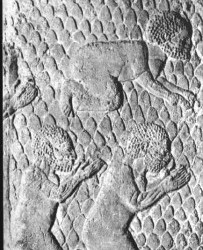
Ancient Hebrews of Lachish
Introduction: According to the standard Jewish Encyclopaedia 96% of all the Jews known to the world today are the descendants of the Khazar tribes of Russia, eastern Europe and western Mongolia; these are the Ashkenazi Jews, the other major sect of the Jews are the Sephardic jews, and they are a bastard people from the mixing of the Canaanites, Hittites, Amorites, Perizzites, Hivites, Jebusites, Girgashites, Kenites, Edomites and some true Israelites. the Jews have never been Isrealites; they are not Israelites now; and they will never be Israelites.
Encyclopedia Americana (1985):
“Ashkenazim, the Ashkenazim are the Jews whose ancestors lived in German lands…it was among Ashkenazi Jews that the idea of political Zionism emerged, leading ultimately to the establishment of the state of Israel…In the late 1960s, Ashkenazi Jews numbered some 11 million, about 84 percent of the world Jewish population.”
The Jewish Encyclopedia:
“Khazars, a non-Semitic, Asiatic, Mongolian tribal nation who emigrated into Eastern Europe about the first century, who were converted as an entire nation to Judaism in the seventh century by the expanding Russian nation which absorbed the entire Khazar population, and who account for the presence in Eastern Europe of the great numbers of Yiddish speaking Jews in Russia, Poland, Lithuania, Galatia, Besserabia and Rumania.”Khazar: Ashkenazi Modern Jew
The Encyclopedia Judaica (1972): The Universal Jewish Encyclopedia: The Universal Jewish Encyclopedia:
“Khazars, a national group of general Turkic type, independent and sovereign in Eastern Europe between the seventh and tenth centuries C.E. During part of this time the leading Khazars professed Judaism…In spite of the negligible information of an archaeological nature, the presence of Jewish groups and the impact of Jewish ideas in Eastern Europe are considerable during the Middle Ages. Groups have been mentioned as migrating to Central Europe from the East often have been referred to as Khazars, thus making it impossible to overlook the possibility that they originated from within the former Khazar Empire.”
The Universal Jewish Encyclopedia:
“The primary meaning of Ashkenaz and Ashkenazim in Hebrew is Germany and Germans. This may be due to the fact that the home of the ancient ancestors of the Germans is Media, which is the Biblical Ashkenaz…Krauss is of the opinion that in the early medieval ages the Khazars were sometimes referred to as Ashkenazim…About 92 percent of all Jews or approximately 14,500,000 are Ashkenazim.”
The Bible: Relates that the Khazar (Ashkenaz) Jews were/are the sons of Japheth not Shem:
“Now these are the generations of the sons of Noah, Shem, Ham, and Japheth: and unto them were sons born after the flood. The sons of Japheth;…the sons of Gomer; Ashkenaz…” (Genesis 10:1-3)
New Standard Jewish Encyclopedia, page 179,[GCP pg 68]
“ASHKENAZI, ASHKENAZIM…constituted before 1963 some nine?tenths of the Jewish people (about 15,000,000 out of 16,5000,000)[ As of 1968 it is believed by some Jewish authorities to be closer to 100%]”
The Outline of History: H. G. Wells,
“It is highly probable that the bulk of the Jew’s ancestors ‘never’ lived in Palestine ‘at all,’ which witnesses the power of historical assertion over fact.”Ancient Hebrews
Under the heading of “A brief History of the Terms for Jew” in the 1980 Jewish Almanac is the following: “Strictly speaking it is incorrect to call an Ancient Israelite a ‘Jew’ or to call a contemporary Jew an Israelite or a Hebrew.” (1980 Jewish Almanac, p. 3).
By
The Bishop
Spread the love
6 notes
·
View notes
Text
I knew I was going to be interested in Esoterica's latest video about the Demiurge, and I knew I was going to look forward to part two coming up, but I find there's an analysis here that points to a god who has a central place in the "Gnostic" "demonisation" of Yahweh, and whose place as such may yet illuminate a pagan lens of what emerges as satanic outsideness.
youtube
The god in question is none other than Set, or Seth, the Egyptian god who ruled over the desert (the Red Land) outside the kingdom of Egypt. For this connection, Justin Sledge leans heavily into M David Litwa's book The Evil Creator: Origins of an Early Christian Idea, which I've since decided I now need a copy of.
It all seems to begin with the myth of Exodus, the Biblical story most people recognise as the one where God brings ten plagues on the land of Egypt to in order to force the pharaoh to release the Israelites from slavery and gets Moses to lead the Israelites out of Egypt. An observation Justin makes is that, for Egyptian audiences, the Exodus story basically positioned the ancient Egyptian gods and the divine pharaoh as being powerless before the might of a single foreign deity, and the pharaoh as dying by drowning, which was apparently considered the worst die in Egypt. To Egyptian eyes, there could not be a more offensive, obscene, or humiliating portrayal of the Egyptian religion, and otherwise, to non-Jews in antiquity, the whole story seemed entirely unbelievable. For all that handwringing about how a foreign god could possibly threaten the good order of the gods of Egypt, there must have been some doubts about that order that entered the mind, if it had to seriously consider the possibility of a god like Yahweh standing toe to toe against Egypt.
But for some people responding to just how far Yahweh went against Egypt at least there was one answer: Yahweh must have been a malevolent donkey-headed god, if not just an angry demon. Or rather, to be more accurate, Yahweh was just Set/Seth, the Egyptian god who was already associated with foreigners who lived outside the kingdom of Egypt.
Set was also at a certain point already identified with Baal, or rather Baal Hadad, the Canaanite god of storms and rain, who Justin says was actually worshipped by nomadic traders in the highlands. That makes for an interesting link as far as local storm gods go. Yet, was Baal really just the main storm of nomadic highlander bandits? The connection to the barbaric outside is an interesting one to say the least, but surely Canaanite religion must have had a certain prominence in antiquity? Unless its presence was also elevated by its interaction with other religious traditions, such as early Judaism, Hellenic polytheism, and Egyptian polytheism? Still, Set being the "demonic" patron of foreigners linked to Baal being the god worshipped by "barbarian nomads" would be just the tip on its own. In a larger sense, one begins to see a massive gulf between that kind of divinity and the Biblical God presented by Christianity. In fact, especially with the link to Baal in mind, the image of Yahweh as Seth and Seth as Iao might seem to have almost nothing to do with the God of Judaism, apart from the calamities attributed to God in the Bible. Whereas Set was an ontologically ambiguous and wild god associated with storms and threats to cosmic and political order, Yahweh or God was associated with the absolute power of cosmic order as the guarantour of political order and sovereignty relevant to the nation of Israel, and only moreso with time, and as time past certain associations with storms, metallurgy, and war gave way to the kind of divinity more associated with El, as well as dominion over celestial objects (which God aggressively emphasizes to Job when he questions the goodness of God). It certainly is a grand and ancient story of recuperation if I ever heard it.
Justin also points out that Set was, after some time, gradually reimagined as a donkey-headed god, whereas in older traditional iconography, Set has the head of a strange creature referred to simply as the "Seth animal" (or "Typhonic beast"), whose actual species (if it was even a real animal species) we still don't know and have no idea what it could be. The donkey association is pervasive in Greco-Egyptian magic, and it seems to have been prevalent enough in Greece at least that Plutarch references the claim that Typhon fled Egypt while riding on an ass for seven days, which Justin says was probably a mockery of the seven days of creation in the Book of Genesis, and that Typhon then sired two sons named Jerusalem and Judea. This, Plutrarch says, is simply an attempt by some people (apparently including Tacitus himself) to drag Jewish traditions into the legends of Typhon. Whatever the intent it does serve to establish that Yahweh was seen as associated with Typhon, perhaps by people who didn't like Judaism to say the least. There seems to be a similar theme with the Roman link between Yahweh and Sabazios, a god who the Romans detested. Of course, never mind the fact that there was an all the more prolific tendency in antiquity to associated Yahweh with Zeus, the chief god of Olmypus and the adversary of Typhon in Greek mythology.
In antiquity, the donkey was considered the "dumbest" of all animals. We probably still think that to some extent today. But in antiquity that was also meant to denote Typhon's irrationality and the foolishness of his conflict with the gods. The donkey image apparently seems to recur throughout antiquity not only in hostile references to Judaism but also in similar references to Christianity. There are unfortunately certain canards in the ancient Greco-Roman world in which Jews were accused of worshipping a golden donkey or donkey head while practicing bloody sacrifices out of hatred for every nation in the world. These were probably not all that commonly believed, but they existed, and they do seem to have been prevalent enough that Jewish authors such as the historian Josephus felt it necessary to refute them. But then later, when Christianity started to emerge as a new religion in town, both Roman polytheists and some Jews occasionally referred to Christians as worshipping a donkey god, using the word "onocoetes" ("he who lies in an ass's manger"), which was meant to imply. And then of course there's the infamous graffito of Alexamenos worshipping his "god": an image of Jesus Christ on the cross with the head of a donkey.
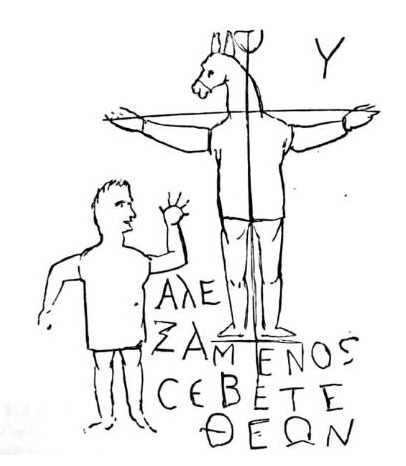
The fact that Christians were accused of worshipping a donkey-headed deity cannot be seen in isolation from Seth already being depicted as a donkey god and him already being associated with Yahweh previously. Perhaps, then, Christians, and Jews prior, were really being accused of worshipping Set. Of course, the accusation was ridiculous and often xenophobic in context. But what it conveys is the idea of worshipping a god seen as "beastly", unlike much of the gods worshipped by Greeks, Romans, and Egyptians (even though those same gods were sometimes worshipped in animal form!).
At the same time, as Jake Stratton Kent elaborated in Geosophia, Seth Typhon was, for a long time, regarded as the patron deity of magicians, as in the very magicians who wrote the spells of the PGM. Kent also elaborated links between Seth-Typhon and not only Dionysus but also Iao, and suggested that they were sometimes identified. Justin also comments on spells in the Greek Magical Papyri, particularly the "erotic" spells, noting that they invoke Seth/Typhon and also show his image (that of the ass/donkey) along the name Iao or variations thereof. I might examine these spells again for the purpose of my PGM notes. Justin at least implies identification between these gods is in play, and in my opinion that is not at all unlikely to be the case. In fact the presence of magical amulets featuring donkey-headed gods and the name Iao probably support that suggestion. And it has to be stressed that, even though the name Iao is invoked, this is an identity that has very little to do with traditional Judaism. Throughout the PGM Iao or Sabaoth or forms thereof are syncretised with polytheistic gods with Helios or outright identified with them, or even subordinate to Helios, all of which is in stark contrast to how God traditionally establishes himself as distinct from all of the other gods and as the sole recipient of worship ("You shall have no other gods before me"). But, speaking of Helios, Kent also also stressed that Seth-Typhon was a solar-pantheistic god, of the kind of solar-pantheistic divinity also represented by gods such as Helios and Abrasax.
The heavy-handed link that Justin (and perhaps M David Litwa as well) presents between Set and Yahweh in the minds of the ancient Egyptians and Hellenes actually makes it much easier to look at a "non-Abrahamic" "satanic outsideness" centered around Set and the Greek Magical Papyri. Well, I say easier, at the least it could provide a much clearer set of clues. I'm already somewhat more interested in the centrality of Seth-Typhon in the notion of divinity in play and its arcane religious outsideness than in any of the standard reasons for which people like Gnosticism. This is where we get not to the standard narrative of the "Judeo-Christian God is the Demiurge keeping people imprisoned from the Pleroma [which is still very much the Christian God!]", but Seth as the insidious "evil" god of magic and chaos, specifically the disorder of matter, but also, perhaps, the heroic strivings of the transgressive magician. There is the possibility of much to be found in common with Satan after all, or at least the Satan of Stanislaw Przybyszewski. There may also in fact be a sense here in which Bataille's Base Materialism and Gnosticism can have a very good effect, not as an analysis of Gnosticism but as illuminating a much greater, lost religious world.
And unfortunately I suppose Soul Hackers 2's Seth also makes a little sense in this light.

Fuck my entire life.
#esoterica#gnosticism#set#seth#seth typhon#typhon seth#yahweh#ancient egypt#demiurge#demons#demonology#magic#satanism#greek magical papyri#greco-egyptian magic#paganism#Youtube#evil
8 notes
·
View notes
Text
So I watched Good Omens 2 for the first time the other day (and I'm being very brave and normal about that ending, thank you), and my brain went "Well all of the angel's names end in -'el', which makes sense cause that means 'God', but Lucifer and Satan don't fit into that naming convention, so where did those names come from?"
And turns out, the answer is fascinating.
The name Lucifer is from Roman paganism and was originally the name of the planet Venus and son of the goddess Aurora (goddess of the dawn). He was also called Phosphoros or Heosphoros, and he heralded of the dawn (it's cute that he's job was to announce that is mom was there)
The original mention of "Lucifer" in the Bible was actually a reference to a fallen King of Babylon, but the translation of the word that means "morning star" to Lucifer has since been abandoned by scholars. This is why historical context of Bible verses matters!
The motif of a being striving for prominence in heaven and then being cast down to the underworld originates in the motions of the planet Venus, also known as the morning star. This motif in myth "The fall from heaven motif is also in Canaanite mythology with Attar trying to get the throne of Ba'al and failing
And then, because I know Satan as a figure isn't really a thing in Judaism, I wondered how he got into Christianity
the Hebrew word "satan" just means "accuser" or "adversary" and in the Old Testament is applied to anyone as an antagonist in the narrative, angels and humans alike
In between the writing of the Old and New Testaments, there was a lot of empire building by Persia and Rome, which led to a lot of contact between religions and idea sharing. One of the ideas that was popular at the time was the separation of Good and Evil into rival forces from Zoroastrianism. While good and evil figures exist in all mythologies, this influence seemed to basis for this binary world view in Christianity
In the New Testament, a lot more references to a satan were added, normally referring to any force that opposed early Christianity, and over time they were conflated and attributed to one being/the Evil Side. The way people talked about it went from someone acting as a satan to people acting as agents of Satan
Then! In looking into all this, I found a mosaic that's thought to be the earliest known depiction of Satan from the 6th century depicting the Parable of the Sheep and the Goats and it's very surprising

(image: mosaic depicting three haloed figures on a rocky green field, Jesus in purple is seated the center, a winged angel in red to Jesus' right and a winged angel in blue to Jesus' left. Both angels have their right hands raised with the palm to the viewer. Jesus is gesturing to the three sheep that stand in front of the angel in red. In front of the angel in blue are three goats)
So the angel in blue is supposed to represent Satan, and in this parable Jesus is explaining Judgment, using sheep to represent those going to Heaven and goats to represent those going to Hell. And this got me thinking about how Satan has been depicted and asking "is this why Satan is so strongly associated with goats?" and the answer is yes, but also no
Because Satan is associated with Evil, and Evil is conceived as anything that is not of God or aligns the the Church's teachings, most pagan deities at some point got associated with Evil or conflated with Satan at some point. Because Rome was the origin point for the spread of Christianity, the two main deities that Satan was conflated with were Hades, which is where the pitchfork imagery and Hell originated, and Pan, which is where Satan being horned and hoofed came from
Hell became conflated with Hades (the place) and because it was Evil, became a place of torment/punishment. This conflation also went well with the previously mentioned "fall from Heaven" motifs which all together originated Satan's mythology
Pan also became associated with Satan for a couple of reasons. One reason was because Pan as a god is associated with pastoralism and roads (which is very interesting considering the Devil's associated with road, especially crossroads), but more importantly, Pan is associated with wild spaces, places outside the realm of Society or "Civilized"
If you know anything about ancient Rome, you know there's nothing that makes ancient Romans nervous more than "uncivilized" things (read: places not under Roman control). Therefore it makes sense that Pan would get conflated with Evil
Pan is also associated heavily with sexuality and his fauns are notoriously sex pests in the mythology. With Rome's newfound obsession with chastity and demonization of anything sexual, it also isn't a surprise that Satan became an overtly sexual being
However, through the middle ages, while Satan was depicted as horned and monstrous (hilariously often with a second face in place of his junk), he wasn't super associated with goats until relatively recently
There is the Parable of the Sheep and the Goats, and there is the scapegoat tradition that takes place at Yom Kippur, where a goat was given all the sins of the community and then released into the wild, but there was also a goat that was dedicated to God and was sacrificed for the holiday feast, so the strong associated with goats and Evil doesn't really exist in the Bible
There's some association with goats and evil in continental European depictions of witches, but that seems to be just cause they're more ornery than sheep, and their association with shepherdesses, like how witches were associated flying brooms because a lot of breweries were run by women and the symbol of the trade was brooms. Basically, witches and evil were associated with things that women of any societal independence had
However, where the goat symbolism really took off for a couple reasons. The first being Goya's paintings of witch's sabbats in the last 18th century that depict the Devil as a goat. This might be reference to the motif that was popular in Spain at the time of an upright quadruped performing routine human activities as a satire of men's follies. Goya specifically used goats, but other depictions of the Devil at the time also used bulls or any other generic horned figure
The second and BIGGEST reason was the image of Baphomet drawn in 1856 by Éliphas Lévi (Remember, this was the time when interest in the occult was high and things like the Spiritualism movement really started kicking off)
This depiction of Baphomet is really interesting in and of itself because Lévi basically cobbled together a bunch of different things from Victorian occultism
Baphomet is meant to be "symbolization of the equilibrium of opposites...half-human and half-animal, male and female, good and evil, etc. Lévi's intention was to symbolize his concept of balance, with Baphomet representing the goal of perfect social order"
The goat part specifically references the "Goat of Mendes" mentioned by Herodotus, who's favorite thing was being xenophobic as fuck. Herodotus says that the Goat of Medes was worshipped in Mendes (the greek name for the Egyptian city Djedet). He goes on to say some pretty slanderous things about the people there but the deity he's referring to seems to be Banebdjedet
Banebdjedet is an Egyptian ram-headed god (are we really going to take the word of Herodotus seriously when the fucker can't even tell goats and rams apart????) who's associated with creation, pottery, and fertility of the Nile floods
Lévi, and other Victorians, took Herodotus at face value and ran with it in his depiction of Baphomet
Baphomet as a figure on the other hand comes from Crusader days, where allegedly the Templars worshipped Baphomet as a deity
The name Baphomet originates from an account of the siege of Antioch; "As the next day dawned, they [i.e. the inhabitants of Antioch] called loudly upon Baphometh; and we prayed silently in our hearts to God, then we attacked and forced all of them outside the city walls". However, the 'Baphometh' the people of Antioch were calling come from the name 'Bafomet', which French troubadours were using to refer to the prophet Muhammad
The idea that the Templars were worshipping Baphomet come from the fact that, because they lived in a predominately Muslim society, some Templars converted to Islam or adopted Muslim practices in their own worship, and they were vilified as a result. So, like with Herodotus, it just originates with the demonization of other people
Getting back to Satan, Lévi's depiction of Baphomet as the "Sabbatic Goat" really became popular among occultists, being used to represent evil in several practices
The imagery got picked up by the King of Fuckwads and Douche-canoes, Aleister Crowley, who made it a central part of his tradition. Because Aleister Crowley unfortunately had such a strong influence on ceremonial magic traditions of the 20th century, the imagery was merged with other horned/antlered deity imagry and was used to represent the Horned God in British Ceremonial Witchcraft and all the derivatives of it (ie; Wicca, Traditional English Witchcraft, ect.)
A few theistic satanist groups also branched out of these ceremonial magic traditions and used Baphomet. Because of the nature of many of these groups (being loud, dickish, and as inflammatory as possible). Combined with the Satanic Panic of the '80's pushed Baphomet as the representation of Satanism to the broader public, rather than just in the social spheres of occult nerds
This of course influenced later branches of Satanism, like the non-theistic Satanic Temple, and popculture depictions of the devil, such as Black Phillip in Robert Eggers' The VVitch
It's all very fascinating. It's so interesting to see how Satan as a figure came about and evolved over the centuries and how that evolution is so rooted in their historical contexts and the values of the people in those times, and how they view the Other. I didn't even get to how the Protestant Revolution or Paradise Lost or Appalachian/Southern folklore changed the depiction of the Devil in the popular consciousness, but it's all super fascinating
#Sword speaks#this turned out to be way longer than I thought sorry#satan#lucifer#the devil#devil#history#baphomet
15 notes
·
View notes
Text

Prayers of the cosmos : meditations on the Aramaic words of Jesus by Neil Douglas-Klotz
“Native peoples in the Middle East also had a rich language, culture, and spirituality for thousands of years before Jesus. His inspired use of many older sacred phrases, reaching back even beyond the Hebrew tradition, shows that a native mystical tradition did survive, probably in hiding or in the desert, both before and throughout the rise of orthodox Judaism, Christianity, and Islam. Some schools of Sufism claim to be among the inheritors of this native Middle Eastern tradition, which precedes even the Egyptian mystery schools.
(...)
The effect of the "mystical" is not to mystify, but to return us to a better relationship with the cosmos, which is the heritage of all native traditions.
(...)
All the major contemporary traditions of the Middle East — Jewish, Christian, and Islamic —stem from the same source, the same earth, and probably the same language. All originally called God either El or Al, which means "That," "the One," or "that One which expresses itself uniquely through all things." From this root arises the sacred names Elat (Old Canaanite), Elohim (Hebrew), Allaha (Aramaic), and Allah (Arabic). If this simple fact became better known, I believe there would be much more tolerance and understanding among those who consciously or unconsciously perpetuate prejudice between what are essentially brother-sister traditions.”
~ Dr. Neil Douglas-Klotz (Shaykh Saadi Shakur Chishti)




#Prayers of the cosmos : meditations on the Aramaic words of Jesus#Neil Douglas-Klotz#Yeshua#Mystical Christianity#Sufi Gnosis#Sufi Philosophy
5 notes
·
View notes
Note
Contrary to what the Bible says, the evidence strongly suggests that Jewish, Samaritan, Syrian, Palestinian and Lebanese populations were originally Canaanite, with the last three becoming culturally Arab. The Exodus never happened and the Israelites were most likely a subgroup of Canaanites. Hebrew is itself belongs to the Canaanite subgroup of the Northwest Semitic languages along with languages like Phoenician.
The situation of the Samaritans in Israel is very interesting. I don’t fully understand the rational behind their not having the same rights as Jews without formal conversion if they are also descended from the Israelites and practise a religion which honestly doesn’t seem very different from Judaism.
i was just reading about the exodus due to ur anon as i’m not particularly informed about it and as you said, it seems evidence does not support it. there probably is some historical accuracy within it, but overall it is not historically accurate. which makes sense, holy books were not written as the events were ongoing but rather passed down and written long after.
and frankly the reasoning is that it is a religious ethnostate! there’s no rationale to any of it beyond that. even converts to judaism get every right in that country that indigenous people to the land do not. it’s transparent as hell. the fact that repeated research has shown palestinians to be descendants of the canaanites, not balkan invaders or russians or arab colonisers from the peninsula or anything else, and yet STILL the argument that they are colonisers in their own country purely bc they’re primarily christians & muslims says more than enough.
5 notes
·
View notes